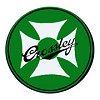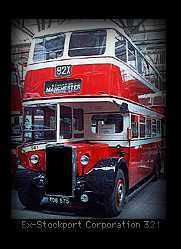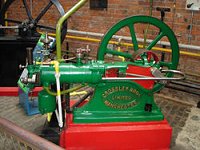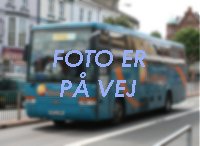Busser > Busproducenter
|
Bustypeoversigt: |
|
Crossley Motors, Manchester (England) |
|
|
Nationalitet: Koncern: BLMC Firmaet grundlagt: 1867 Produktion 1926-1958: 5.500 busser Internetadresse: www. Firmaets postadresse: Crossley Motors, Manchester, Englend |
|
|
|
|
HistoryCrossley BrothersCrossley Brothers was set up in 1867 by Francis (1839 - 1897) and William (Sir William from 1909) (1844 - 1911). Francis, with help from his uncle, bought the engineering business of John M Dunlop at Great Marlborough Street in Manchester city centre, including manufacturing pumps, presses, and small steam engines. William joined his brother shortly after the purchase. The company name was initially changed to Crossley Brothers and Dunlop. Each of the brothers had served engineering apprenticeships: Francis, known as Frank, at Robert Stephenson; and William at W G Armstrongs, both in Newcastle upon Tyne. William concentrated on the business side, Frank provided the engineering expertise. The brothers were committed Christians and strictly teetotal, refusing to supply their products to companies such as breweries, whom they did not approve of. They adopted the early Christian symbol of the Coptic Cross (Coptic Christianity) as the emblem to use on their road vehicles. In 1869 they had the foresight to acquire the UK and world (except German) rights to the patents of Otto and Langden of Cologne for the new gas fuelled atmospheric internal combustion engine and in 1876 these rights were extended to the famous Otto four-stroke cycle engine. The change over to four stroke engines was remarkably rapid with the last atmospheric engines being made in 1877. The business flourished. In 1881, Crossley Brothers became a private limited company, and then, in 1882, it moved to larger premises in Pottery Lane, Openshaw, in east Manchester. Further technical improvements also followed, including the introduction of poppet valves and the hot-tube ignitor in 1888 and the introduction of the carburetor, allowing volatile liquid fuels to be used. By adopting the heavier fuelled "Oil" engine, the first one being demonstrated in 1891, the companies future was assured. Then in 1896, they obtained rights to the Diesel system, which used the heat of compression alone to ignite the fuel. Their first diesel was built in 1898. By the turn of the century, there was also some production of petrol engines, and from 1901 these engines were finding their way into road vehicles, including, in 1905, Leyland buses. Crossley Motors
With the steady increase in vehicle production, the limits of the Gorton site were again soon reached, and in 1914 a further 48 acre (194,000 m²) site was bought in Heaton Chapel, Stockport which became the Errwood Park Works. Construction of the new factory started in 1915, and although intended to relieve congestion on the old site, it was rapidly given over to war work. The western half the site, built in 1917, but only managed by the Crossley Motors, became National Aircraft Factory No 2. In 1919, this factory was bought from the government and became the Willys Overland Crossley plant, but was eventually sold to Fairey Aviation in 1934. In 1938, the eastern side became another aircraft factory, this time managed by Fairey, and after the second world war, became the final home of Crossley Motors. Re-armament work caused the search for more space and in 1938 a factory was opened in Greencroft Mill,Hyde about 3 miles east of Errwood Park. In 1920 Crossley Motors bought the nearby A V Roe and Company better known as Avro. They had to sell the company to Armstrong-Siddeley in 1928 to pay for the losses incurred in Willys-Overland-Crossley. As the market for hand made cars began to disappear in the late 1920s the company moved into the bus market and launched its first model, the Eagle in 1928. The last cars were made in 1937 but by then in addition to buses there was large production of military vehicles as part of the re-armament process. After World War 2 there was a boom in the bus industry as war time losses needed to be replaced. Crossley won what was then the largest ever British export order for buses with a contract with the Dutch government. By the late 1940s bus orders were decreasing and it became clear that the company was too small to continue as an independent manufacturer and in 1948 they were sold to AEC. The last chassis was made in 1951 but body production continued at Erwood Park until 1958. Although not trading the company was never formally wound up and in 1969 AEC's new owner, British Leyland, restarted the company with a new name, Leyland National, and production of single decker buses recommenced. (kilde: Wikipedia)
|
||||||||||||||||||||||||||||
|
|
|---|



 Crossley Motors Ltd was first registered on the 11th April 1906 (and re-registered with a different company number in 1910) as the vehicle manufacturing arm of Crossley Brothers. The first car was actually built in 1904, but clearly the parent company saw a future for these new machines and decided a separate company was required. Originally based in the main factory in 1907 they moved to a nearby site they owned in Napier Street, Gorton, Manchester. (Napier Street was later changed to Crossley Street).
Crossley Motors Ltd was first registered on the 11th April 1906 (and re-registered with a different company number in 1910) as the vehicle manufacturing arm of Crossley Brothers. The first car was actually built in 1904, but clearly the parent company saw a future for these new machines and decided a separate company was required. Originally based in the main factory in 1907 they moved to a nearby site they owned in Napier Street, Gorton, Manchester. (Napier Street was later changed to Crossley Street).
